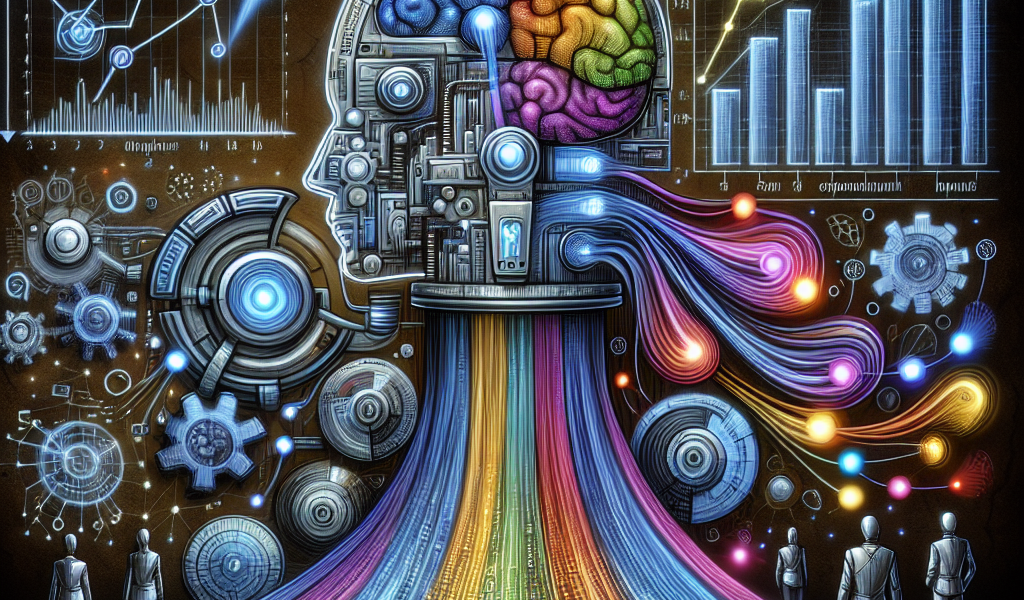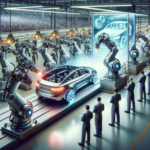-
Table of Contents
“Unlocking Tomorrow: How AI Transforms Predictive Analytics Today”
Introduction

Artificial Intelligence (AI) is revolutionizing the field of predictive analytics by providing advanced tools and methodologies that significantly enhance the accuracy and efficiency of data-driven predictions. By leveraging machine learning algorithms, natural language processing, and deep learning techniques, AI enables the analysis of vast and complex datasets that were previously beyond human capability. This allows for more precise forecasting in various domains such as finance, healthcare, marketing, and supply chain management. AI-driven predictive analytics can identify patterns, trends, and correlations that traditional statistical methods might miss, leading to more informed decision-making and strategic planning. Furthermore, AI systems continuously learn and adapt from new data, ensuring that predictive models remain relevant and accurate over time. As a result, businesses and organizations can anticipate future events with greater confidence, optimize operations, and gain a competitive edge in their respective industries.
Leveraging Machine Learning Algorithms for Improved Predictive Accuracy
In recent years, the field of predictive analytics has undergone a significant transformation, largely due to the advent of artificial intelligence (AI) and machine learning algorithms. These technological advancements are not only enhancing the accuracy of predictions but also expanding the scope of what can be predicted. As businesses and organizations increasingly rely on data-driven decision-making, the integration of AI into predictive analytics is proving to be a game-changer.
One of the primary ways AI is enhancing predictive analytics is through the use of sophisticated machine learning algorithms. Traditional statistical methods, while effective to a certain extent, often fall short when dealing with large and complex datasets. Machine learning algorithms, on the other hand, excel in these scenarios by identifying patterns and relationships that might be missed by human analysts. For instance, in the realm of finance, AI-driven predictive models can analyze vast amounts of market data to forecast stock prices with greater precision. This not only helps investors make more informed decisions but also mitigates risks associated with market volatility.
Moreover, the ability of machine learning algorithms to continuously learn and adapt is another significant advantage. Unlike static models that require manual updates, AI systems can automatically refine their predictions as new data becomes available. This dynamic nature ensures that the predictive models remain relevant and accurate over time. In the healthcare sector, for example, AI-powered predictive analytics can analyze patient data to predict disease outbreaks or identify individuals at high risk of developing chronic conditions. By doing so, healthcare providers can implement preventive measures and allocate resources more efficiently, ultimately improving patient outcomes.
Transitioning to another critical aspect, the integration of AI in predictive analytics also facilitates the handling of unstructured data. Traditional analytics methods often struggle with unstructured data such as text, images, and videos. However, machine learning algorithms, particularly those involving natural language processing (NLP) and computer vision, can effectively process and analyze this type of data. In the retail industry, for example, AI can analyze customer reviews and social media posts to gauge consumer sentiment and predict future purchasing trends. This enables retailers to tailor their marketing strategies and inventory management to better meet customer demands.
Furthermore, the scalability of AI-driven predictive analytics cannot be overstated. As organizations grow and their data volumes increase, the need for scalable solutions becomes paramount. Machine learning algorithms can handle vast amounts of data across multiple sources, providing comprehensive insights that drive strategic decision-making. In the energy sector, for instance, AI can analyze data from various sensors and meters to predict energy consumption patterns. This allows utility companies to optimize their operations, reduce costs, and enhance service reliability.
Despite these advancements, it is important to acknowledge the challenges associated with leveraging AI for predictive analytics. Data quality and privacy concerns remain significant hurdles. Ensuring that the data used to train machine learning models is accurate and representative is crucial for reliable predictions. Additionally, organizations must navigate the ethical implications of using AI, particularly in terms of data privacy and bias. Addressing these challenges requires a concerted effort from both technology developers and policymakers to establish robust frameworks and guidelines.
In conclusion, the integration of AI and machine learning algorithms into predictive analytics is revolutionizing the way organizations forecast future events and trends. By enhancing predictive accuracy, enabling the analysis of unstructured data, and offering scalable solutions, AI is empowering businesses to make more informed decisions. As technology continues to evolve, the potential for AI-driven predictive analytics to transform various industries is boundless, promising a future where data-driven insights lead to smarter, more efficient outcomes.
Real-Time Data Processing and Its Impact on Predictive Models
In the rapidly evolving landscape of technology, artificial intelligence (AI) has emerged as a transformative force, particularly in the realm of predictive analytics. The integration of AI into real-time data processing is revolutionizing how businesses and organizations forecast future trends, behaviors, and outcomes. This synergy between AI and predictive analytics is not only enhancing the accuracy of predictions but also enabling more dynamic and responsive decision-making processes.
One of the most significant impacts of AI on predictive analytics is its ability to process vast amounts of data in real-time. Traditional predictive models often relied on historical data, which, while valuable, could not always account for the rapid changes and nuances of the present moment. AI, however, can analyze current data streams as they are generated, providing a more immediate and relevant understanding of trends. This real-time data processing capability allows businesses to react swiftly to emerging patterns, thereby gaining a competitive edge.
Moreover, AI’s advanced algorithms can identify complex patterns and correlations within data that might be missed by human analysts. Machine learning, a subset of AI, enables predictive models to learn from new data continuously, refining their accuracy over time. For instance, in the financial sector, AI-driven predictive analytics can detect subtle market shifts and predict stock price movements with greater precision. This not only aids investors in making informed decisions but also helps in mitigating risks associated with market volatility.
Transitioning to another critical aspect, the healthcare industry is also witnessing profound benefits from AI-enhanced predictive analytics. Real-time data from wearable devices, electronic health records, and other sources can be analyzed to predict patient outcomes, such as the likelihood of disease progression or the risk of readmission. This proactive approach allows healthcare providers to intervene earlier, improving patient care and reducing costs. Additionally, AI can help in identifying potential outbreaks of diseases by analyzing patterns in real-time data, thereby enabling quicker public health responses.
Furthermore, the retail sector is leveraging AI to enhance customer experiences through predictive analytics. By analyzing real-time data from various touchpoints, such as online browsing behavior, purchase history, and social media interactions, AI can predict consumer preferences and personalize marketing efforts. This not only increases customer satisfaction but also drives sales and loyalty. Retailers can optimize inventory management by predicting demand more accurately, reducing waste, and ensuring that popular products are always in stock.
Despite these advancements, it is essential to acknowledge the challenges that come with integrating AI into predictive analytics. Data privacy and security concerns are paramount, as real-time data processing often involves sensitive information. Ensuring that AI systems are transparent and that their decision-making processes can be audited is crucial for maintaining trust. Additionally, the quality of data is a critical factor; inaccurate or biased data can lead to flawed predictions, underscoring the need for robust data governance practices.
In conclusion, the fusion of AI and real-time data processing is significantly enhancing the capabilities of predictive analytics across various sectors. By providing more accurate, timely, and actionable insights, AI is enabling businesses and organizations to make better-informed decisions, anticipate future trends, and respond proactively to changes. As technology continues to advance, the potential for AI to further transform predictive analytics is immense, promising a future where data-driven decision-making is more precise and impactful than ever before.
Enhancing Customer Insights Through AI-Driven Predictive Analytics
In today’s fast-paced digital landscape, businesses are constantly seeking innovative ways to understand and anticipate customer behavior. One of the most transformative tools in this endeavor is predictive analytics, which leverages historical data to forecast future trends. With the advent of artificial intelligence (AI), predictive analytics has reached new heights, offering unprecedented insights into customer preferences and behaviors. This synergy between AI and predictive analytics is revolutionizing how companies engage with their customers, ultimately enhancing customer insights in ways previously unimaginable.
To begin with, AI-driven predictive analytics allows businesses to analyze vast amounts of data with remarkable speed and accuracy. Traditional methods of data analysis often fall short when dealing with the sheer volume and complexity of modern datasets. However, AI algorithms can sift through terabytes of information, identifying patterns and correlations that might elude human analysts. This capability is particularly valuable in understanding customer behavior, as it enables companies to predict future actions based on past interactions. For instance, by analyzing purchase history, browsing patterns, and social media activity, AI can help businesses anticipate what products a customer is likely to buy next, thereby enabling more targeted marketing efforts.
Moreover, AI enhances predictive analytics by continuously learning and adapting to new data. Unlike static models, AI systems can update their predictions in real-time as new information becomes available. This dynamic nature ensures that businesses always have the most current insights at their disposal. For example, if a sudden shift in consumer sentiment occurs due to a viral social media trend, AI can quickly adjust its predictions to reflect this change. This agility allows companies to stay ahead of the curve, responding to emerging trends before they become mainstream.
In addition to improving the accuracy and timeliness of predictions, AI-driven predictive analytics also offers a more granular understanding of customer behavior. Traditional analytics might provide broad trends and averages, but AI can delve deeper into individual customer profiles. By segmenting customers based on various attributes such as demographics, purchase history, and online behavior, AI can create highly personalized predictions. This level of detail enables businesses to tailor their marketing strategies to individual customers, enhancing the overall customer experience. For instance, a retailer could use AI to identify a segment of customers who are likely to be interested in a new product line, then target those customers with personalized promotions and recommendations.
Furthermore, AI-driven predictive analytics can help businesses identify and mitigate potential risks. By analyzing patterns of customer behavior, AI can flag anomalies that may indicate fraudulent activity or customer churn. For example, if a customer who typically makes regular purchases suddenly stops engaging with a brand, AI can alert the business to this change, allowing them to take proactive measures to retain the customer. This proactive approach not only helps in retaining customers but also in maintaining the integrity of the business.
As AI continues to evolve, its integration with predictive analytics will only become more sophisticated. Emerging technologies such as natural language processing and machine learning are already enhancing the capabilities of predictive models, enabling even deeper insights into customer behavior. As a result, businesses that leverage AI-driven predictive analytics will be better positioned to understand and anticipate their customers’ needs, ultimately driving growth and fostering stronger customer relationships.
In conclusion, the fusion of AI and predictive analytics is transforming the way businesses gain insights into customer behavior. By enabling faster, more accurate, and more personalized predictions, AI is helping companies stay ahead of the competition and deliver exceptional customer experiences. As this technology continues to advance, its impact on predictive analytics will undoubtedly grow, offering even greater opportunities for businesses to enhance their understanding of their customers.
Conclusion
AI is significantly enhancing predictive analytics by leveraging advanced algorithms and machine learning techniques to analyze vast amounts of data more accurately and efficiently. It enables the identification of complex patterns and trends that traditional methods might miss, leading to more precise predictions and better decision-making. AI-driven predictive analytics also allows for real-time data processing and continuous learning, which improves the adaptability and responsiveness of predictive models. Consequently, businesses can achieve greater operational efficiency, optimize resource allocation, and gain a competitive edge in their respective markets.





